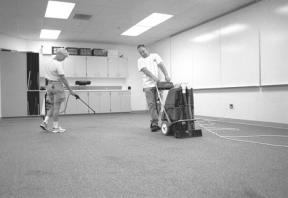South Whidbey’s school buildings are not in bad shape and, with a few hundred thousand dollars from taxpayers, they will be useable for decades into the future. So for the summer, this means that a good cleaning and some basic maintenance will be almost all that’s needed to get the schools in shape. Almost.
Though it’s summer vacation for students, the South Whidbey School district’s custodial and maintenance crews will be busy cleaning and fixing the district’s most durable assets right up to Labor Day. Meanwhile, the district’s maintenance supervisor and district administrators are mulling over the idea of going out to voters to ask for another $250,000 to fix some things that are in dire need of repair.
The dog days of summer allow the staff to work without interruption from teacher requests and crowded buildings. These days, school buildings are quiet now except for the sound of rock ‘n’ roll music blaring from radios and the hum of carpet cleaning machines.
“Summer allows us the chance to take care of basic repairs and remodeling inside the buildings and restoring playing fields,” said Rick Pitt, district facilities manager.
Pitt and his five-member maintenance crew are taking care of work this summer that needed to be done but had to wait for the end of the school year. They are building walls in the high school and intermediate school, doing some interior painting and refinishing gym floors.
Each year, wood gym floors are lightly sanded then topped with a clear finish.
Pitt explained that wood floors can only be sanded four times without wearing them out. For that reason, gym floors are lightly roughed up, then topped with a clear finish.
Other annual maintenance chores include cleaning water tanks, pumping school building septic systems, and restoring playfields.
This summer maintenance staff recently in hauled 300 yards of sand for the high school and middle school play fields, then reseeded and watered grassy areas.
“Now it’s up to Mother Nature,” Pitt said.
Custodians — a total of 14 — are busy at each school cleaning classrooms, hallways and furniture. For the summer, hallways are piled high with chairs, tables and desks while custodians clean classroom carpets and walls.
Custodians are assigned to each building and are supervised by school principals.
While these activities take care of general maintenance and cleaning, they do not address some larger issues of needed repairs and replacements. Most of the school buildings are wearing and will need some fixes that require more than the summer maintenance budget can give.
That’s hardly surprising, since the amount of space at the schools has grown so much, especially during the past decade. The oldest section of Langley Middle School was constructed in 1935 with and last remodelled in 1996 and 1997. The school’s sixth-grade wing was built the 1960s and the gym in 1949. The district’s intermediate school was built in 1988, while the primary school is two decades older. South Whidbey High School has seen the most changes since it was first built in 1981. The district finished a massive renovation and addition project at the school in 1997.
All these add-ons and updates — which include 100,000 new square feet since Langley Middle School was built — combined with the age of the older portions of some school buildings, have the maintenance department looking for more money.
“The buildings grew but supplies haven’t,” Pitt said. “As a result we have been falling about $50,000 behind per year since 1996. The supplies and maintenance budget was figured on so many dollars per student, rather than the amount of actual building space.
A captial projects levy would allow us to catch up.”
During a recent South Whidbey Board of Education workshop, Pitt presented his list of maintenance priorities, including roof replacement, heating upgrades, flooring replacement and updating classroom technology throughout the district.
To fund these priorities, the district’s budget committee is considering a four-year, $250,000 capital projects levy.
“The only way to get a lot of these things done is with a capital projects levy,” Pitt said.
The proposed levy would cost taxpayers 10 cents per $1,000 of their property value. Taxpayers are currently paying $1.40 per $1,000 for the district’s operating levy.
Pitt’s specific requests include upgrading computers in all the schools; replacing flooring at the primary school, middle school, Bayview High School, the intermediate school and Shared Schooling Cooperative modular building. Other items on his list include a new roof and a heating system upgrade for the middle school, a plumping upgrade at the primary school, and an asphalt overlay for the high school tennis courts.
A water filtration system for the three buildings on Maxwelton — the high, intermediate and primary schools — is also on the list. Pitt said this would address complaints about the appearance of the water, which has a high manganese and iron content. He noted that this is not a health hazard or safety issue.
One project favored by the district, re-roofing the Primary School, is nearing completion. The bid –$125,000–to re roof everything but the gym at the Primary School will be completed before school begins in September.
With additional maintenance funds and due to falling enrollment, the district will likely make its current buildings last for some time. Though the district at one time considered building a new school building on 47 acres it owns behind the intermediate school, no new schools are being considered at this time.



